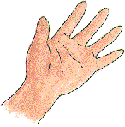 |
Human
Body Unit |
 |
The Sunflower/Girasol unit on the Human Body is divided into three main sections, each exploring a different theme:
1. We are each physically unique human beings.
2. Our bodies respond to change, and to the world around us.
3. We need to take care of our bodies in order to remain healthy.
In the first section, students explore some of the ways in which their own bodies are special. For example, children discover that even though humans as a rule maintain a very steady body temperature, there are noticeable differences in the temperatures of our hands. Students also measure and compare the lengths (and circumferences) of different parts of their bodies, and then graph these measurements. In this section children also learn about why they have different-colored skin and different types of hair, and engage in activities designed to help them value that diversity. As an extension activity, students may look at their own fingerprints, to see how they fall into one of 3 general patterns, and yet are each individually unique.
In the second section, students discover that the human body is able to adapt to changes in our own activities, and to changes in our environment. For example, students explore the changes in heart rate and respiration rate that occur as a result of increased exercise. Students experiment with the senses of taste and touch, and see how these are influenced by other senses. Children also learn about reaction times, and experiment with ways to improve their own reaction times. As an extension activity, students may be asked to check the heart rates of different members of their family at home, or to graph changes in their own pulse rates.
In the final section, students focus on activities which influence the health of our bodies specifically, diet and exercise. Students record everything they eat over a 24-hour period, and then compare their eating habits to those suggested by the "food pyramid" of the American Dietetic Association. As an extension activity, the teacher may ask students to experiment with ways that different foods dissolve in water, and begin to appreciate the complex work that is involved in digestion. Students also explore ways that they exercise their bodies, through work or through play. Finally, they have the opportunity to compare diet and exercise in this country with that in their parents' countries, and see if there are things we can learn from the differences in our cultures.
The length of time the Human Body Unit takes to complete depends on the number of extension activities you choose to do. In total, you should expect to spend about 5 weeks.
View the Sunflower/Girasol Evaluation Report
| Air |
Plant |
Water |
Human
Body |
Trash |
Sound |
 |
 |
 |
 |
 |
 |
|






